TRENDNET TEW630APB 300Mbps Wireless N Draft AP User Manual revised 0929
TRENDNET, INC. 300Mbps Wireless N Draft AP revised 0929
TRENDNET >
User manual
300Mbps Wireless N Draft AP
TEW-630APB
User Manual
1
Federal Communication Commission Interference Statement
This equipment has been tested and found to comply with the limits for a Class B
digital device, pursuant to Part 15 of the FCC Rules. These limits are designed to
provide reasonable protection against harmful interference in a residential installation.
This equipment generates, uses and can radiate radio frequency energy and, if not
installed and used in accordance with the instructions, may cause harmful interference
to radio communications. However, there is no guarantee that interference will not
occur in a particular installation. If this equipment does cause harmful interference to
radio or television reception, which can be determined by turning the equipment off
and on, the user is encouraged to try to correct the interference by one of the following
measures:
l Reorient or relocate the receiving antenna.
l Increase the separation between the equipment and receiver.
l Connect the equipment into an outlet on a circuit different from that to which the
receiver is connected.
l Consult the dealer or an experienced radio/TV technician for help.
FCC Caution: Any changes or modifications not expressly approved by the party
responsible for compliance could void the user's authority to operate this equipment.
This device complies with Part 15 of the FCC Rules. Operation is subject to the
following two conditions: (1) This device may not cause harmful interference, and (2)
this device must accept any interference received, including interference that may
cause undesired operation.
IMPORTANT NOTE:
FCC Radiation Exposure Statement:
This equipment complies with FCC radiation exposure limits set forth for an
uncontrolled environment. This equipment should be installed and operated with
minimum distance 20cm between the radiator & your body.
This transmitter must not be co-located or operating in conjunction with any other
antenna or transmitter.
The availability of some specific channels and/or operational frequency bands are
country dependent and are firmware programmed at the factory to match the intended
destination. The firmware setting is not accessible by the end user.
2
European Union Notice:
Radio products with the CE marking comply with the R&TTE Directive (1999/5/EC), the
EMC Directive (89/336/EEC) and the Low Voltage Directive (73/23/EEC) issued by the
Commission of the European Community.
Compliance with these directives implies conformity to the following European Norms:
l EN 60950 Product Safety
l EN 300 328 Technical requirement for radio equipment
l EN 301 489-1/-17 General EMC requirements for radio equipment
Trademark recognition
All product names used in this manual are the properties of their respective owners and are
acknowledged.
3
Table of Contents
Getting Started with the WAP-372U.................................4
Package
Contents .............................................5
Minimum System Requirements .................................
5
Wireless LAN
Networking ..........................................6
Introduction....................................................
10
Features....................................................
.10
Hardware
Overview ...............................................11
Rear
Panel...................................................11
LEDs........................................................
.12
Installation
Considerations ..................................13
Getting
Started ..............................................13
Using the Configuration
Menu.....................................14
Basic.......................................................
.15
Advanced....................................................
.25
Tool........................................................
.29
Status......................................................
4
.36
Glossary........................................................
41

5
Getting Started with the WAP-372U
Congratulations on purchasing the WAP-372U! This manual provides information for setting up
and configuring the WAP-372U. This manual is intended for both home users and
professionals.
The following
conventions are used
in this manual:
THE NOTE SYMBOL INDICATES ADDITIONAL INFORMATION ON THE
TOPIC AT HAND.
THE TIP SYMBOL INDICATES HELPFULL INFORMATION AND TIPS TO
IMPROVE YOUR NETWORK EXPERIENCE.
THE CAUTION SYMBOL ALERTS YOU TO SITUATIONS THAT MAY
DEGRADE YOUR NETWORKING EXPERIENCE OR COMPROMISE
YOUR SECURITY.
LIKE NOTES AND TIPS, THE IMPORTANT SYMBOL INDICATES
INFORMATION THAT CAN IMPROVE NETWORKING. THIS INFORMATION
SHOULD NOT BE OVERLOOKED.

6
Package Contents
l WAP-372U 11n (Draft) AP
l CAT-5 Ethernet Cable ( the WAP-372U’s Ethernet ports is Auto-MDIX)
l Power Adapter (5.0V, 2.5A)
l CD-ROM with Manual
l Quick Installation Guide
Using a power supply with a different voltage than the one included with your
product will cause damage and void the warranty for this product.
Minimum System Requirements
l Computers with Windows, Macintosh, or Linux-based operating systems with an
installed Ethernet adapter and CD-ROM.
l Internet Explorer Version 6.0 or Netscape Navigator Version 7.0 and Above

7
Wireless LAN Networking
This section provides background information on wireless LAN networking technology.
Consult the “Glossary” for definitions of the terminology used in this section.
THE INFORMATION IN THIS SECTION IS FOR YOUR REFERENCE. CHANGING
NETWORK SETTINGS AND PARTICULARLY SECURITY SETTTINGS SHOULD
ONLY BE DONE BY AN AUTHORIZED ADMINISTRATOR.
Transmission Rate (Transfer Rate)
The WAP-372U provides various transmission (data) rate options for you to select. In most
networking scenarios, the factory default Best (Auto) setting proves the most efficient. This
setting allows your WAP-372U to operate at the maximum transmission (data) rate. When the
communication quality drops below a certain level, the WAP-372U automatically switches to a
lower transmission (data) rate. Transmission at lower data speeds is usually more reliable.
However, when the communication quality improves again, the WAP-372U gradually increases
the transmission (data) rate again until it reaches the highest available transmission rate.
Types of Wireless Networks
Wireless LAN networking works in either of the two modes: ad-hoc and infrastructure. In infra-
structure mode, wireless devices communicate to a wired LAN via access points. Each access
point and its wireless devices are known as a Basic Service Set (BSS). An Extended Service Set
(ESS) is two or more BSSs in the same subnet. In ad hoc mode (also known as peer-to-peer
mode), wireless devices communicate with each other directly and do not use an access point.
This is an Independent BSS (IBSS).
To connect to a wired network within a coverage area using access points, set the WAP-372U
operation mode to Infrastructure (BSS). To set up an independent wireless workgroup without an
access point, use Ad-hoc (IBSS) mode.
AD-HOC (IBSS) NETWORK
Ad-hoc mode does not require an access point or a wired network. Two or more wireless stations
communicate directly to each other. An ad-hoc network may sometimes be referred to as an
Independent Basic Service Set (IBSS).
To set up an ad-hoc network, configure all the stations in ad-hoc mode. Use the same SSID
and channel for each station.
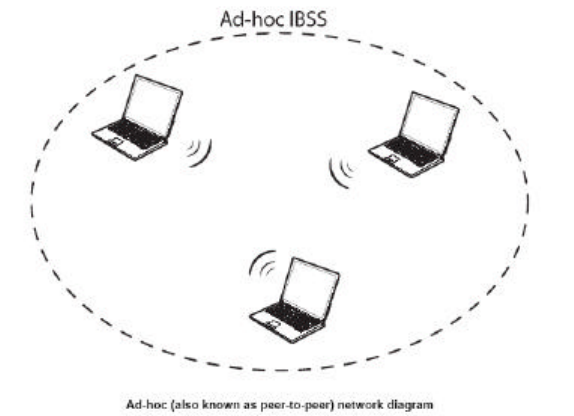
8
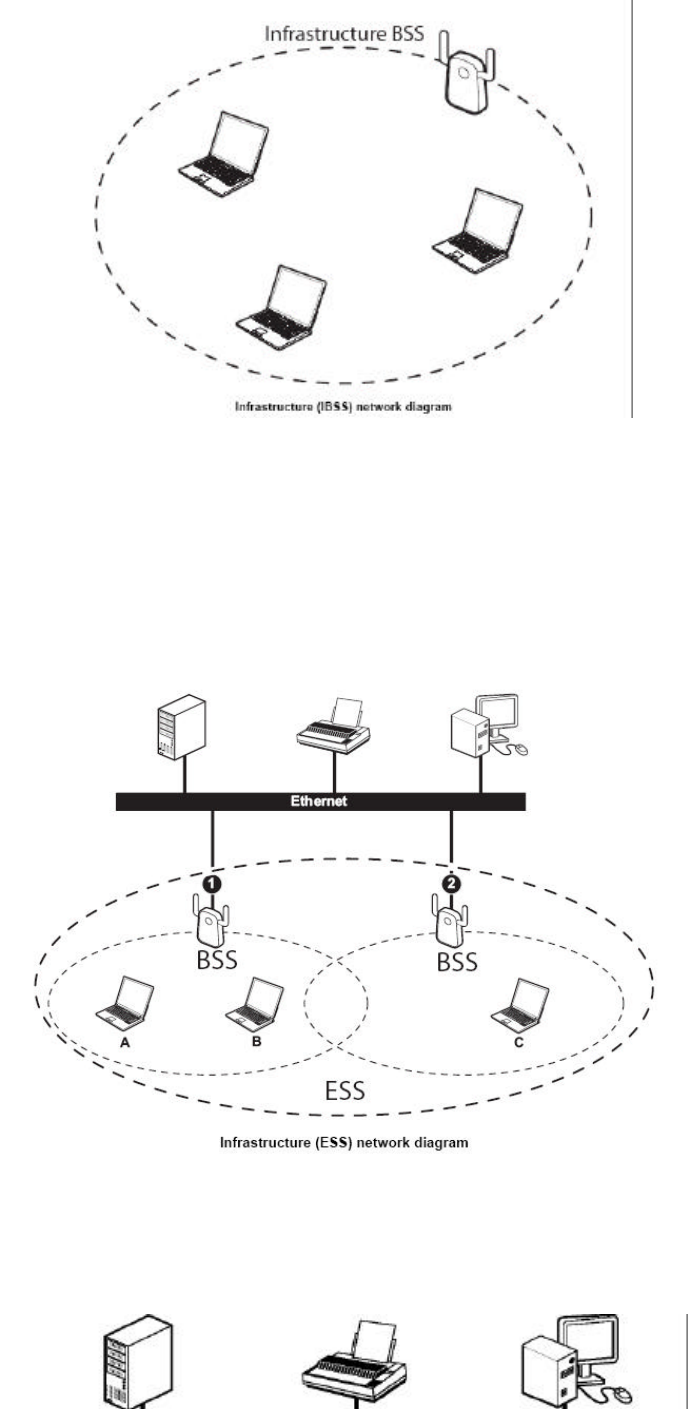
9
When a number of wireless stations are connected using a single access point, you have a
Basic Service Set (BSS).
In the ESS diagram below, communication is done through the access points, which relay data
packets to other wireless stations or devices connected to the wired network. Wireless stations
can then access resources, such as a printer, on the wired network.
In an ESS environment, users are able to move from one access point to another without losing
the connection. In the diagram below, when the user moves from BSS (1) to BSS (2) the
WAP-372U automatically switches to the channel used in BSS (2).
10
11
Introduction
The WAP-372U is an 802.11n (draft) high-performance, wireless AP that supports high-speed
wireless networking at home, at work or in public places.
Unlike most APs, the WAP-372U provides data transfers at up to 300 Mbps when used with other
11n (draft) products. This AP is backwards compatible with 802.11b/g products. This means that
you do not need to change your entire network to maintain connectivity. You may sacrifice some of
802.11g’s speed when you mix 802.11n (draft) and 802.11g devices, but you will not lose the
ability to communicate when you incorporate the 802.11n (draft) into your 802.11g network. You
may choose to slowly change your network by gradually replacing the 802.11g devices with
802.11n (draft) devices.
Features
Ø Supports IEEE 802.11n (draft) & 11b/g 2.4GHz wireless Local Area Network (WLAN)
application
Ø 2.412 to 2.484GHz frequency band operation
Ø Compliant with IEEE 802.3 & 3u standards
Ø Support OFDM and CCK modulation
Ø Data rates of 1,2.5.5,6,9,12,18,24,36,48,54Mbps and 802.11n (draft) offering up to 300Mbps.
Ø Support one LAN port
Ø Support WEP & WPA security
Ø Support three external antennas
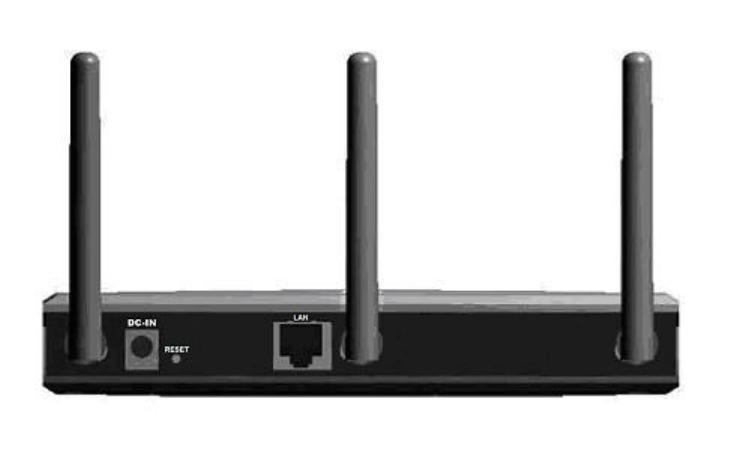
12
Hardware Overview
Real Panel
DC-IN
The DC power input connector is a single jack socket to supply power to the WAP-372U.
Please use the Power Adapter provided on the WAP-372U package.
Auto MDI/MDIX LAN Ports
This port automatically senses the cable type when connecting to Router.
Reset Button
Pressing the reset button restores the AP to its original factory default settings.
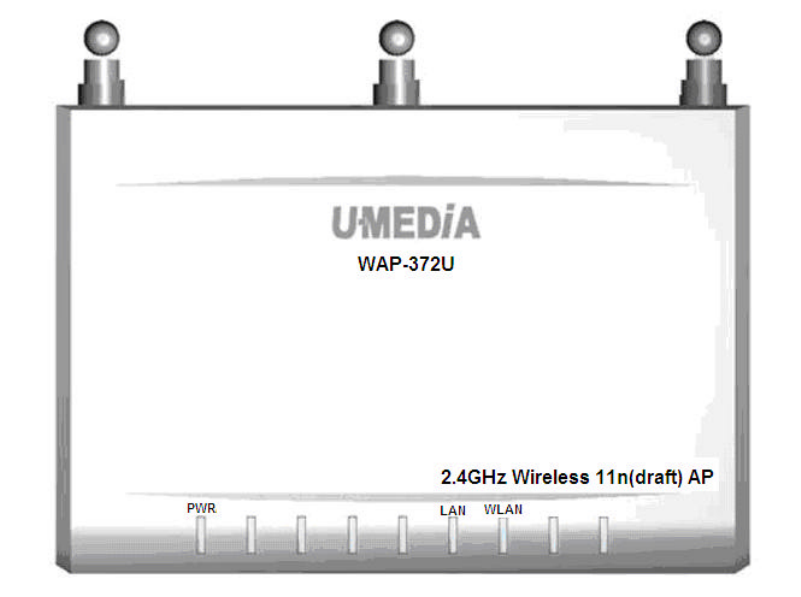
13
LEDs
POWER LED
A solid light indicates a proper connection to the power supply.
LAN LED
A solid light indicates a connection to a Router on the LAN port. This LED blinks during data
transmission.
WLAN LED
A solid light indicates that the wireless segment is ready. This LED blinks during wireless data
transmission.
Installation Considerations

Page 14
The WAP-372U AP lets you access your network, using a wireless connection, from virtually
anywhere within its operating range. Keep in mind, however, that the number, thickness and
location of walls, ceilings, or other objects that the wireless signals must pass through, may limit
the range. Typical ranges vary depending on the types of materials and background RF (radio
frequency) noise in your home or business. The key to maximizing wireless range is to follow these
basic guidelines:
1 Keep the number of walls and ceilings between the WAP-372U and other network devices
to a minimum - each wall or ceiling can reduce your wireless product’s range from 3-90
feet (1-30 meters.) Position your devices so that the number of walls or ceilings is
minimized.
2 Be aware of the direct line between network devices. A wall that is 1.5 feet thick (.5 meters),
at a 45-degree angle appears to be almost 3 feet (1 meter) thick. At a 2-degree angle it
looks over 42 feet (14 meters) thick! Position devices so that the signal will travel straight
through a wall or ceiling (instead of at an angle) for better reception.
3 Building Materials can impede the wireless signal - a solid metal door or aluminum studs
may have a negative effect on range. Try to position wireless devices and computers with
wireless adapters so that the signal passes through drywall or open doorways and not other
materials.
4 Keep your product away (at least 3-6 feet or 1-2 meters) from electrical devices or
appliances that generate extreme RF noise.
Getting Started
For a typical wireless setup at home, please do the following:
1. Plug the power adapter to outlay, and connect the power jack to the WAP-372U.
2. Connect the Ethernet LAN port of the WAP-372U to your PC.
3. Open your web browser, and type http://192.168.1.100 to login WAP-372U.
4. When the authentication window is popped up, type the admin for the username, and leave
the password as blank, then type enter to login the web page of the WAP-372U.
5. Configure the desired wireless setting.
6. Connect the Ethernet port of the WAP-372U to your router.
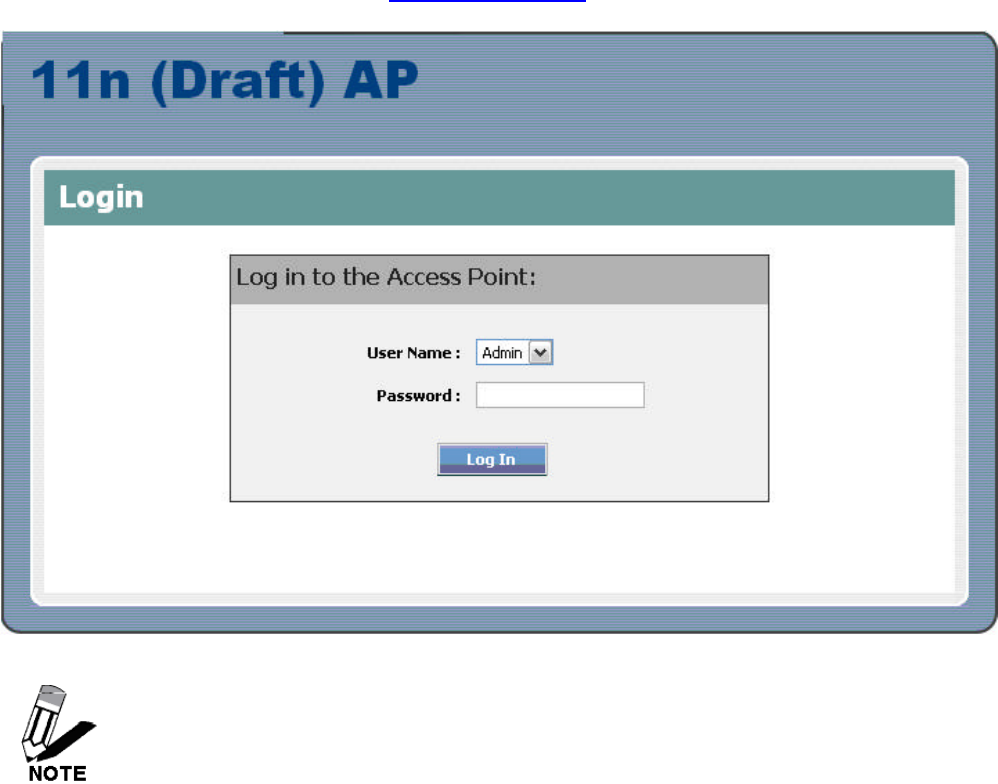
Page 15
Using the Configuration Menu
Whenever you want to configure your WAP-372U, you can access the Configuration Menu by
opening the Web-browser and typing in the IP Address of the WAP-372U. The WAP-372U’s
default IP Address is http://192.168.1.100.
Ø Open the Web browser.
Ø Type in the IP Address of the AP (http://192.168.1.100).
If you have changed the default IP Address assigned to the WAP-372U, make sure to
enter the correct IP Address.
Ø Type admin in the User Name field.
Ø Leave the Password blank.
Ø Click Login In.
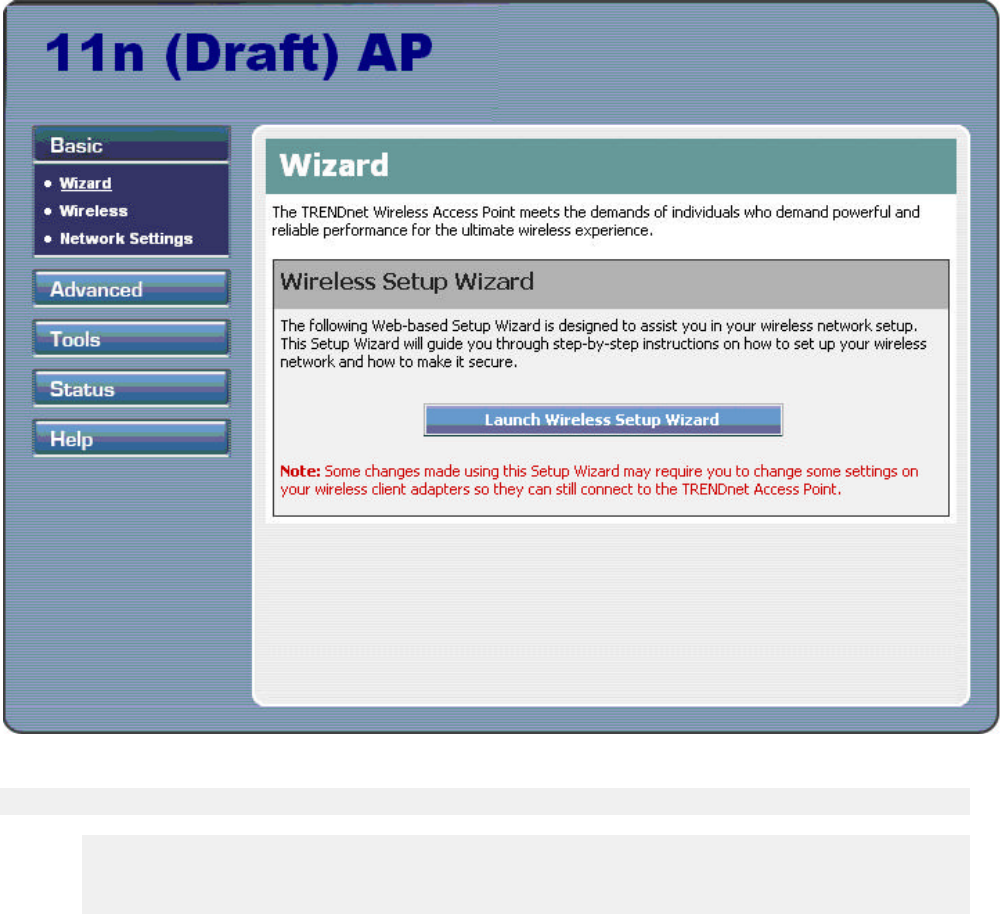
Page 16
Basic
The Basic tab provides the following configuration options: Wizard, Wireless and Network Settings.
Basic_Wizard
Wireless Setup Wizard
If you are new to networking and have never configured an access point before, click on
Launch Wireless Setup Wizard and the wizard will guide you through a few simple
steps to get your network up and running.
Basic_Wireless
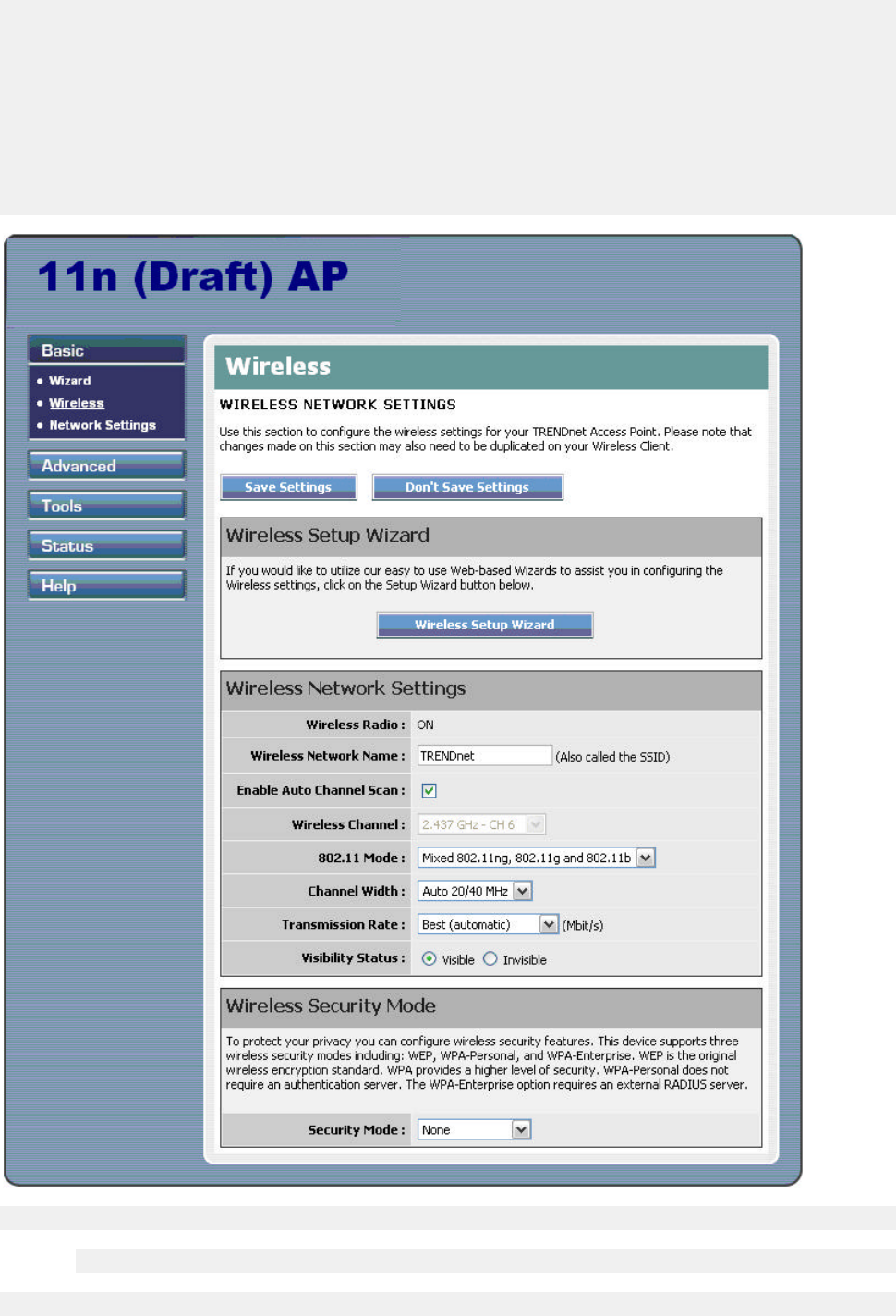
Page 17
The wireless section is used to configure the wireless settings for your Access Point. Note that
changes made in this section may also need to be duplicated on wireless clients that you want to
connect to your wireless network.
To protect your privacy, use the wireless security mode to configure the wireless security features.
This device supports three wireless security modes including: WEP, WPA-Personal, and
WPA-Enterprise. WEP is the original wireless encryption standard. WPA provides a higher level of
security. WPA-Personal does not require an authentication server. The WPA-Enterprise option does
require a RADIUS authentication server.
Wireless Radio
This status indication shows you the wireless radio is on or off.
Wireless Network Name

Page 18
When you are browsing for available wireless networks, this is the name that will appear
in the list (unless Visibility Status is set to Invisible, see below). This name is also referred
to as the SSID. For security purposes, it is highly recommended to change from the
pre-configured network name.
Enable Auto Channel Scan
If you select this option, the Access Point automatically finds the channel with least
interference and uses that channel for wireless networking. If you disable this option, the
Access Point uses the channel that you specify with the following Wireless Channel
option.
Wireless Channel
A wireless network uses specific channels in the wireless spectrum to handle
communication between clients. Some channels in your area may have interference from
other electronic devices. Choose the clearest channel to help optimize the performance
and coverage of your wireless network.
802.11 Mode
If all of the wireless devices you want to connect with this Access Point can connect in the
same transmission mode, you can improve performance slightly by choosing the
appropriate "Only" mode. If you have some devices that use a different transmission
mode, choose the appropriate "Mixed" mode.
Channel Width
The "Auto 20/40 MHz" option is usually best. The other options are available for special
circumstances.
Transmission Rate
By default the fastest possible transmission rate will be selected. You have the option of
selecting the speed if necessary.
Visibility Status
The Invisible option allows you to hide your wireless network. When this option is set to
Visible, your wireless network name is broadcast to anyone within the range of your signal.
If you're not using encryption then they could connect to your network. When Invisible
mode is enabled, you must enter the Wireless Network Name (SSID) on the client
manually to connect to the network.
Security Mode
Unless one of these encryption modes is selected, wireless transmissions to and from your
wireless network can be easily intercepted and interpreted by unauthorized users.
WEP
A method of encrypting data for wireless communication intended to provide the same
level of privacy as a wired network. WEP is not as secure as WPA encryption. To gain
access to a WEP network, you must know the key. The key is a string of characters that
you create. When using WEP, you must determine the level of encryption. The type of
encryption determines the key length. 128-bit encryption requires a longer key than 64-bit
encryption. Keys are defined by entering in a string in HEX (hexadecimal - using

Page 19
characters 0-9, A-F) or ASCII (American Standard Code for Information Interchange -
alphanumeric characters) format. ASCII format is provided so you can enter a string that
is easier to remember. The ASCII string is converted to HEX for use over the network.
Four keys can be defined so that you can change keys easily. A default key is selected for
use on the network.
Example:
64-bit hexadecimal keys are exactly 10 characters in length. (12345678FA is a valid string
of 10 characters for 64-bit encryption.)
128-bit hexadecimal keys are exactly 26 characters in length.
(456FBCDF123400122225271730 is a valid string of 26 characters for 128-bit encryption.)
64-bit ASCII keys are up to 5 characters in length (DMODE is a valid string of 5 characters
for 64-bit encryption.)
128-bit ASCII keys are up to 13 characters in length (2002HALOSWIN1 is a valid string of
13 characters for 128-bit encryption.)
Note that, if you enter fewer characters in the WEP key than required, the remainder of
the key is automatically padded with zeros.
WPA-Personal and WPA-Enterprise
Both of these options select some variant of Wi-Fi Protected Access (WPA) -- security
standards published by the Wi-Fi Alliance. The WPA Mode further refines the variant that
the Access Point should employ.
WPA Mode: WPA is the older standard; select this option if the clients that will be used
with the Access Point only support the older standard. WPA2 is the newer implementation
of the stronger IEEE 802.11i security standard. With the "WPA or WPA2" option, the
Access Point tries WPA2 first, but falls back to WPA if the client only supports WPA. The
strongest cipher that the client supports will be used. With the "WPA2 Only" option, the
Access Point associates only with clients that also support WPA2 security. The AES cipher
will be used across the wireless network to ensure best security.
Group Key Update Interval: The amount of time before the group key used for
broadcast and multicast data is changed.
WPA-Personal
This option uses Wi-Fi Protected Access with a Pre-Shared Key (PSK).
Pre-Shared Key: The key is entered as a pass-phrase of up to 63 alphanumeric
characters in ASCII (American Standard Code for Information Interchange) format at both
ends of the wireless connection. It cannot be shorter than eight characters, although for
proper security it needs to be of ample length and should not be a commonly known
phrase. This phrase is used to generate session keys that are unique for each wireless
client.
Example:
Wireless Networking technology enables ubiquitous communication
WPA-Enterprise
This option works with a RADIUS Server to authenticate wireless clients. Wireless clients
should have established the necessary credentials before attempting to authenticate to

Page 20
the Server through this Gateway. Furthermore, it may be necessary to configure the
RADIUS Server to allow this Gateway to authenticate users.
Authentication Timeout: Amount of time before a client will be required to
re-authenticate.
RADIUS Server IP Address: The IP address of the authentication server.
RADIUS Server Port: The port number used to connect to the authentication server.
RADIUS Server Shared Secret: A pass-phrase that must match with the authentication
server.
MAC Address Authentication: If this is selected, the user must connect from the same
computer whenever logging into the wireless network.
Advanced:
Optional Backup RADIUS Server
This option enables configuration of an optional second RADIUS server. A second RADIUS
server can be used as backup for the primary RADIUS server. The second RADIUS server
is consulted only when the primary server is not available or not responding. The fields
Second RADIUS Server IP Address, RADIUS Server Port, Second RADIUS server
Shared Secret, Second MAC Address Authentication provide the corresponding
parameters for the second RADIUS Server.
Basic_Network Settings
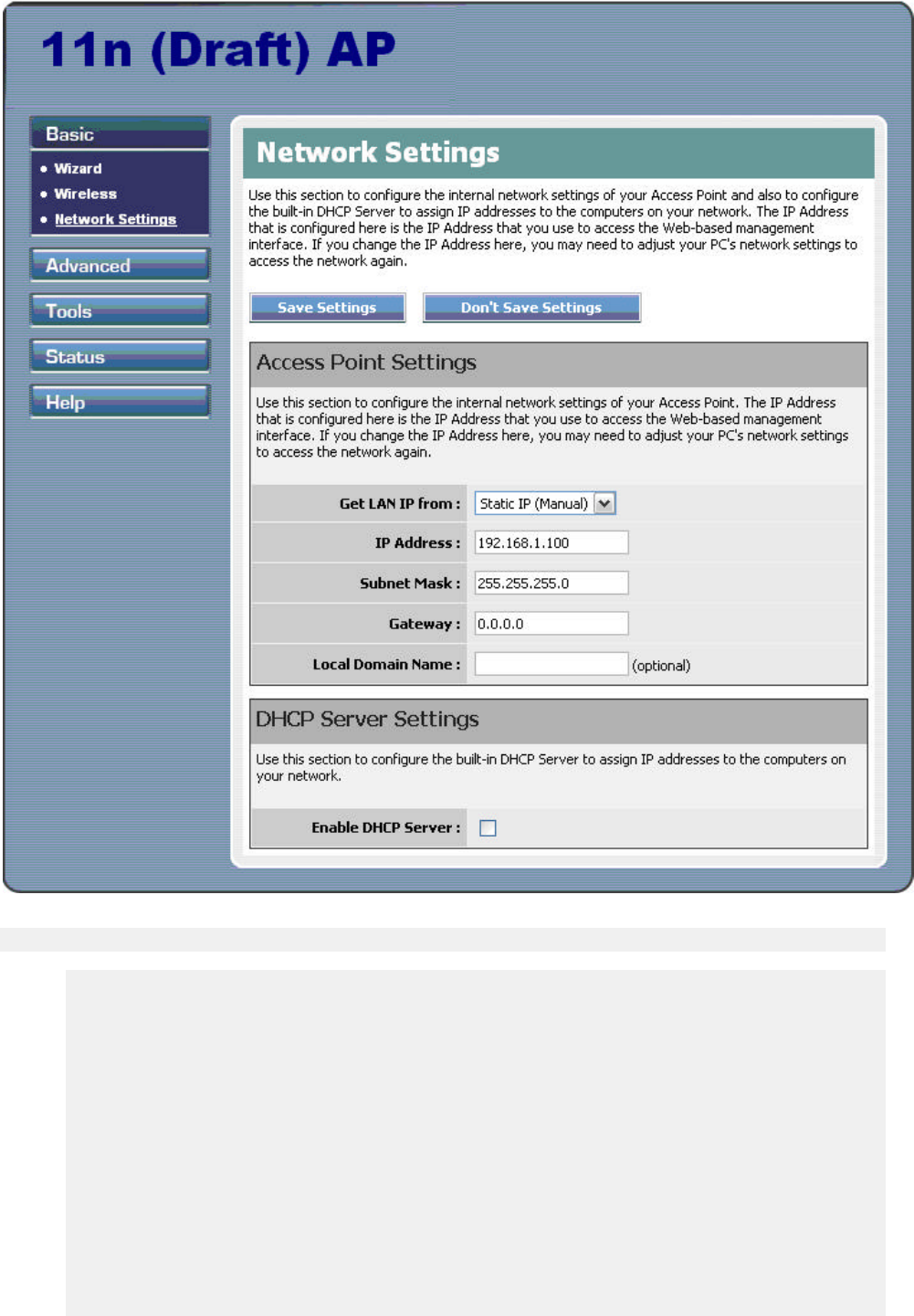
Page 21
Access Point Settings
These are the settings of the LAN (Local Area Network) interface for the Access Point. The
Access Point's local network (LAN) settings are configured based on the IP Address and
Subnet Mask assigned in this section. The IP address is also used to access this Web-based
management interface.
Get LAN IP From
Choose "DHCP (Dynamic)" if your router supports DHCP and you want the router to assign
an IP address to the AP. In this case, you do not need to fill in the following fields. Choose
"Static IP (Manual)" if your router does not support DHCP or if for any other reason you
need to assign a fixed address to the AP. In this case, you must also configure the
following fields.
Note that you cannot choose "DHCP (Dynamic)" if you have enabled the "DHCP Server"
option on the DHCP page; the AP cannot be both a DHCP client and a DHCP server.

Page 22
IP Address
The IP address of the AP on the local area network. Assign any unused IP address in the
range of IP addresses available for the LAN. For example, 192.168.1.100.
Subnet Mask
The subnet mask of the local area network.
Gateway
The IP address of the router on the local area network.
Local Domain Name
This entry is optional. Enter a domain name for the local network. The AP's DHCP server
will give this domain name to the computers on the wireless LAN. So, for example, if you
enter mynetwork.net here, and you have a wireless laptop with a name of chris,
that laptop will be known as chris.mynetwork.net. Note, however, if the AP's
settings specify "DHCP (Dynamic)" Address, and the router's DHCP server assigns a domain
name to the AP, that domain name will override any name you enter here.
DHCP Server Settings
DHCP stands for Dynamic Host Configuration Protocol. The DHCP section is where you
configure the built-in DHCP Server to assign IP addresses to the computers and other
devices on your local area network (LAN).
Enable DHCP Server
In most situations, the router provides DHCP services, and you can leave this option
disabled. However, if for any reason the router does not provide DHCP services, enable this
option. The AP's DHCP Server will then manage the IP addresses and other network
configuration information for wireless clients associated with the AP.
The computers (and other devices) connected to your LAN also need to have their TCP/IP
configuration set to "DHCP" or "Obtain an IP address automatically".
When you set Enable DHCP Server, the following options are displayed.
DHCP IP Address Range
These two IP values (from and to) define a range of IP addresses that the DHCP Server
uses when assigning addresses to computers and devices on your Local Area Network. Any
addresses that are outside of this range are not managed by the DHCP Server; these could,
therefore, be used for manually configured devices or devices that cannot use DHCP to
obtain network address details automatically.
It is possible for a computer or device that is manually configured to have an address that
does reside within this range. In this case the address should be reserved, so that the
DHCP Server knows that this specific address can only be used by a specific computer or
device.
Your Access Point, by default, has a static IP address of 192.168.1.100. This means that
addresses 192.168.1.101 to 192.168.1.254 can be made available for allocation by the
DHCP Server.
Example:

Page 23
Your Access Point uses 192.168.1.1 for the IP address. You've assigned a computer that
you want to designate as a Web server with a static IP address of 192.168.1.101. You've
assigned another computer that you want to designate as an FTP server with a static IP
address of 192.168.1.102. Therefore the starting IP address for your DHCP IP address
range needs to be 192.168.1.103 or greater.
Example:
Suppose you configure the DHCP Server to manage addresses From 192.168.1.101 To
192.168.1.199. This means that 192.168.1.1 to 192.168.1.99 and 192.168.1.200 to
192.168.1.254 are NOT managed by the DHCP Server. Computers or devices that use
addresses from these ranges are to be manually configured. Suppose you have a web
server computer that has a manually configured address of 192.168.1.101. Because this
falls within the "managed range" be sure to create a reservation for this address and match
it to the relevant computer.
DHCP Lease Time
The amount of time that a computer may have an IP address before it is required to renew
the lease. The lease functions just as a lease on an apartment would. The initial lease
designates the amount of time before the lease expires. If the tenant wishes to retain the
address when the lease is expired then a new lease is established. If the lease expires and
the address is no longer needed than another tenant may use the address.
Always Broadcast
If all the computers on the LAN successfully obtain their IP addresses from the Access
Point's DHCP server as expected, this option can remain disabled. However, if one of the
computers on the LAN fails to obtain an IP address from the Access Point's DHCP server, it
may have an old DHCP client that incorrectly turns off the broadcast flag of DHCP packets.
Enabling this option will cause the Access Point to always broadcast its responses to all
clients, thereby working around the problem, at the cost of increased broadcast traffic on
the LAN.
Add/Edit DHCP Reservation
This option lets you reserve IP addresses, and assign the same IP address to the network
device with the specified MAC address any time it requests an IP address. This is almost
the same as when a device has a static IP address except that the device must still request
an IP address from the Access Point. The Access Point will provide the device the same IP
address every time. DHCP Reservations are helpful for server computers on the local
network that are hosting applications such as Web and FTP. Servers on your network
should either use a static IP address or use this option.
Computer Name
You can assign a name for each computer that is given a reserved IP address. This may
help you keep track of which computers are assigned this way. Example: Game Server.
IP Address:
The LAN address that you want to reserve.
MAC Address
To input the MAC address of your system, enter it in manually or connect to the Access
Point's Web-Management interface from the system and click the Copy Your PC's MAC
Address button.

Page 24
A MAC address is usually located on a sticker on the bottom of a network device. The MAC
address is comprised of twelve digits. Each pair of hexadecimal digits are usually separated
by dashes or colons such as 00-0D-88-11-22-33 or 00:0D:88:11:22:33. If your network
device is a computer and the network card is already located inside the computer, you can
connect to the Access Point from the computer and click the Copy Your PC's MAC
Address button to enter the MAC address.
As an alternative, you can locate a MAC address in a specific operating system by following
the steps below:
Windows 98
Windows Me Go to the Start menu, select Run, type in winipcfg, and hit Enter. A
popup window will be displayed. Select the appropriate adapter from the
pull-down menu and you will see the Adapter Address. This is the MAC
address of the device.
Windows 2000
Windows XP Go to your Start menu, select Programs, select Accessories, and select
Command Prompt. At the command prompt type ipconfig /all
and
hit Enter. The physical address displayed for the adapter connecting to
the Access Point is the MAC address.
Mac OS X Go to the Apple Menu, select System Preferences, select Network, and
select the Ethernet Adapter connecting to the Access Point. Select the
Ethernet button and the Ethernet ID will be listed. This is the same as
the MAC address.
DHCP Reservations List
This shows clients that you have specified to have reserved DHCP addresses. An entry can
be changed by clicking the Edit icon, or deleted by clicking the Delete icon. When you click
the Edit icon, the item is highlighted, and the "Edit DHCP Reservation" section is activated
for editing.
Number of Dynamic DHCP Clients
In this section you can see what LAN devices are currently leasing IP addresses.
Revoke
The Revoke option is available for the situation in which the lease table becomes full or
nearly full, you need to recover space in the table for new entries, and you know that some
of the currently allocated leases are no longer needed. Clicking Revoke cancels the lease
for a specific LAN device and frees an entry in the lease table. Do this only if the device no
longer needs the leased IP address, because, for example, it has been removed from the
network.
Reserve
The Reserve option converts this dynamic IP allocation into a DHCP Reservation and
adds the corresponding entry to the DHCP Reservations List.
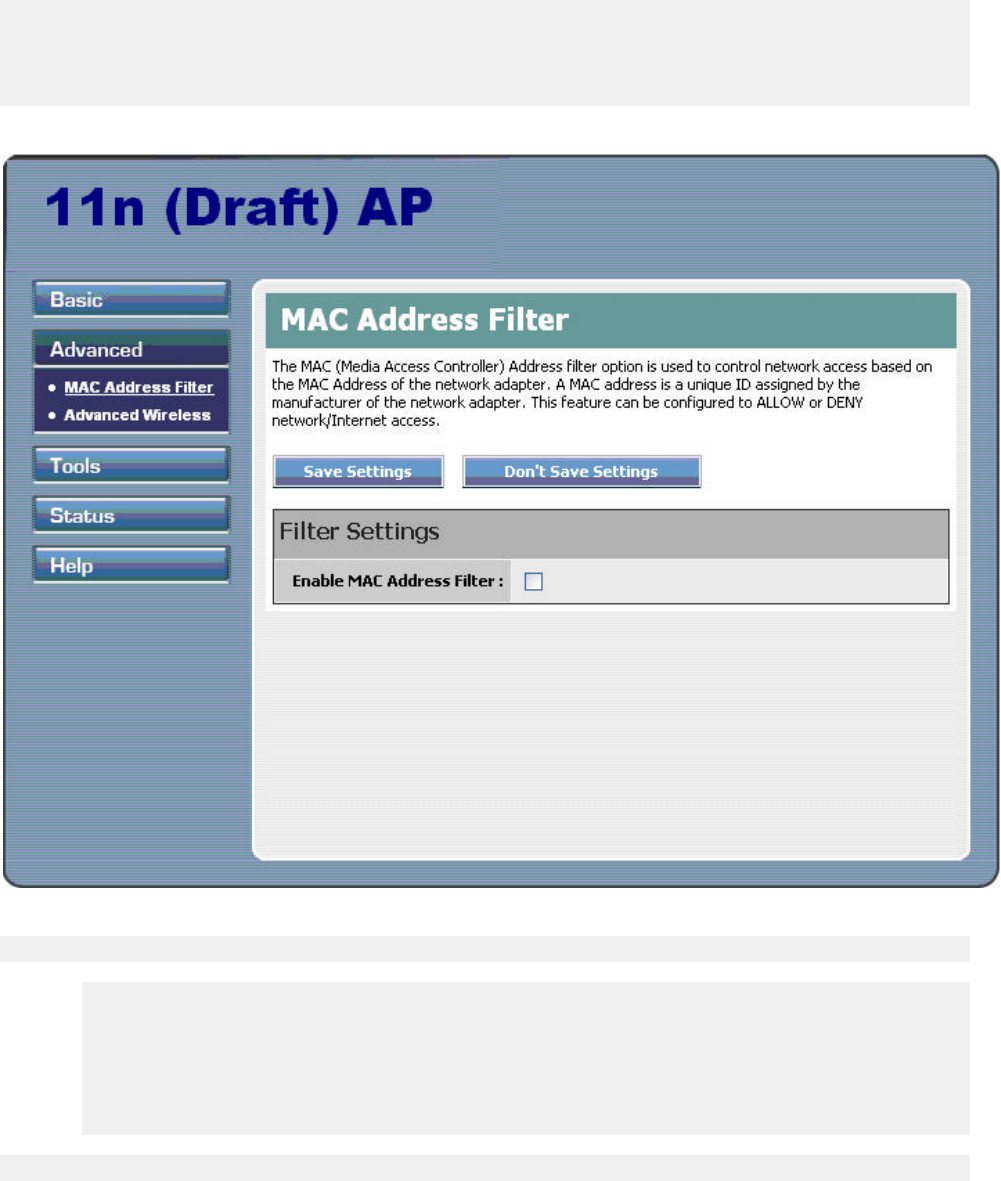
Page 25
Advanced
The Advanced tab provides the following configuration options: MAC Address Filter and
Advanced Network.
Advanced_MAC Address Filter
The MAC address filter section can be used to filter network access by machines based on the
unique MAC addresses of their network adapter(s). It is most useful to prevent unauthorized
wireless devices from connecting to your network. A MAC address is a unique ID assigned by the
manufacturer of the network adapter.
Enable MAC Address Filter
When this is enabled, computers are granted or denied network access depending on the
mode of the filter.
Note: Misconfiguration of this feature can prevent any machine from accessing the
network. In such a situation, you can regain access by activating the factory defaults
button on the Access Point itself.
Filter Settings

Page 26
Mode
When "only allow listed machines" is selected, only computers with MAC addresses listed
in the MAC Address List are granted network access. When "only deny listed machines" is
selected, any computer with a MAC address listed in the MAC Address List is refused
access to the network.
Filter Wireless Clients
When this is selected, the MAC address filters will be applied to wireless network clients.
Filter Wired Clients
When this is selected, the MAC address filters will be applied to wired network clients.
Add/Edit MAC Address
In this section, you can add entries to the MAC Address List below, or edit existing entries.
Enable
MAC address entries can be activated or deactivated with this checkbox.
MAC Address
Enter the MAC address of the desired computer or connect to the Access Point from the
desired computer and click the Copy Your PC's MAC Address button.
Save
Saves the new or edited MAC Address entry in the following list. When finished updating
the MAC Address List, you must still click the Save Settings button at the top of the
page to make the changes effective and permanent.
MAC Address List
The section lists the current MAC Address filters. A MAC Address entry can be changed by
clicking the Edit icon, or deleted by clicking the Delete icon. When you click the Edit icon,
the item is highlighted, and the "Edit MAC Address" section is activated for editing.
Advanced_Advanced Wireless
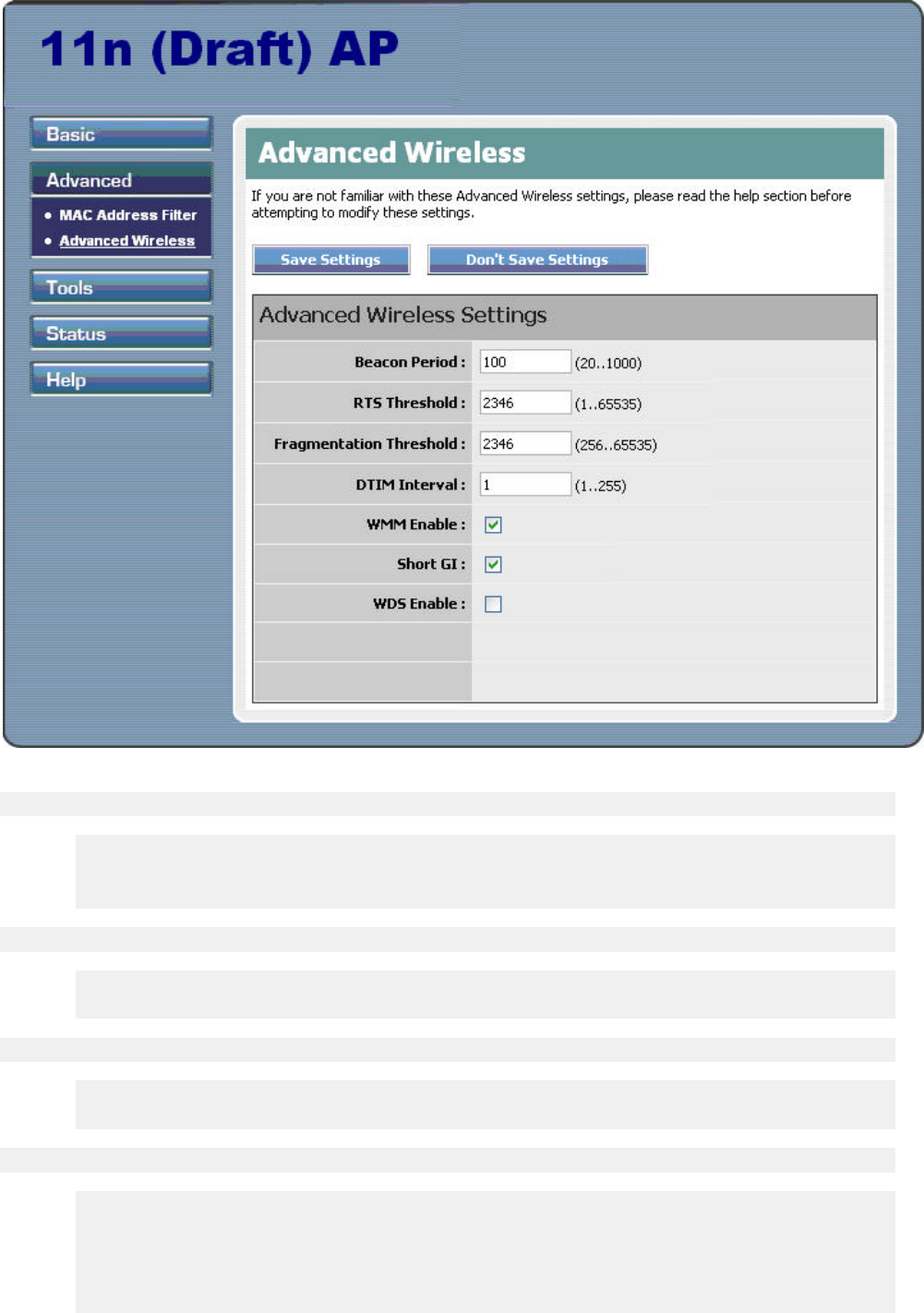
Page 27
Beacon Period
Beacons are packets sent by a wireless Access Point to synchronize wireless devices.
Specify a Beacon Period value between 20 and 1000. The default value is set to 100
milliseconds.
RTS Threshold
This setting should remain at its default value of 2346. If you encounter inconsistent data
flow, only minor modifications to the value are recommended.
Fragmentation Threshold
This setting should remain at its default value of 2346. Setting the Fragmentation value
too low may result in poor performance.
DTIM Interval
A DTIM is a countdown informing clients of the next window for listening to broadcast and
multicast messages. When the wireless Access Point has buffered broadcast or multicast
messages for associated clients, it sends the next DTIM with a DTIM Interval value.
Wireless clients detect the beacons and awaken to receive the broadcast and multicast
messages. The default value is 1. Valid settings are between 1 and 255.

Page 28
WMM Enable
Enabling WMM can help control latency and jitter when transmitting multimedia content
over a wireless connection.
Short GI
Using a short (400ns) guard interval can increase throughput. However, it can also
increase error rate in some installations, due to increased sensitivity to radio-frequency
reflections. Select the option that works best for your installation.
WDS Enable
When WDS is enabled, this access point functions as a wireless repeater and is able to
wirelessly communicate with other APs via WDS links. Note that WDS is incompatible with
WPA -- both features cannot be used at the same time. A WDS link is bidirectional; so this
AP must know the MAC Address (creates the WDS link) of the other AP, and the other AP
must have a WDS link back to this AP. Make sure the APs are configured with same
channel number.
WDS AP MAC Address
Specifies one-half of the WDS link. The other AP must also have the MAC address of this
AP to create the WDS link back to this AP. Enter a MAC address for each of the other APs
that you want to connect with WDS.
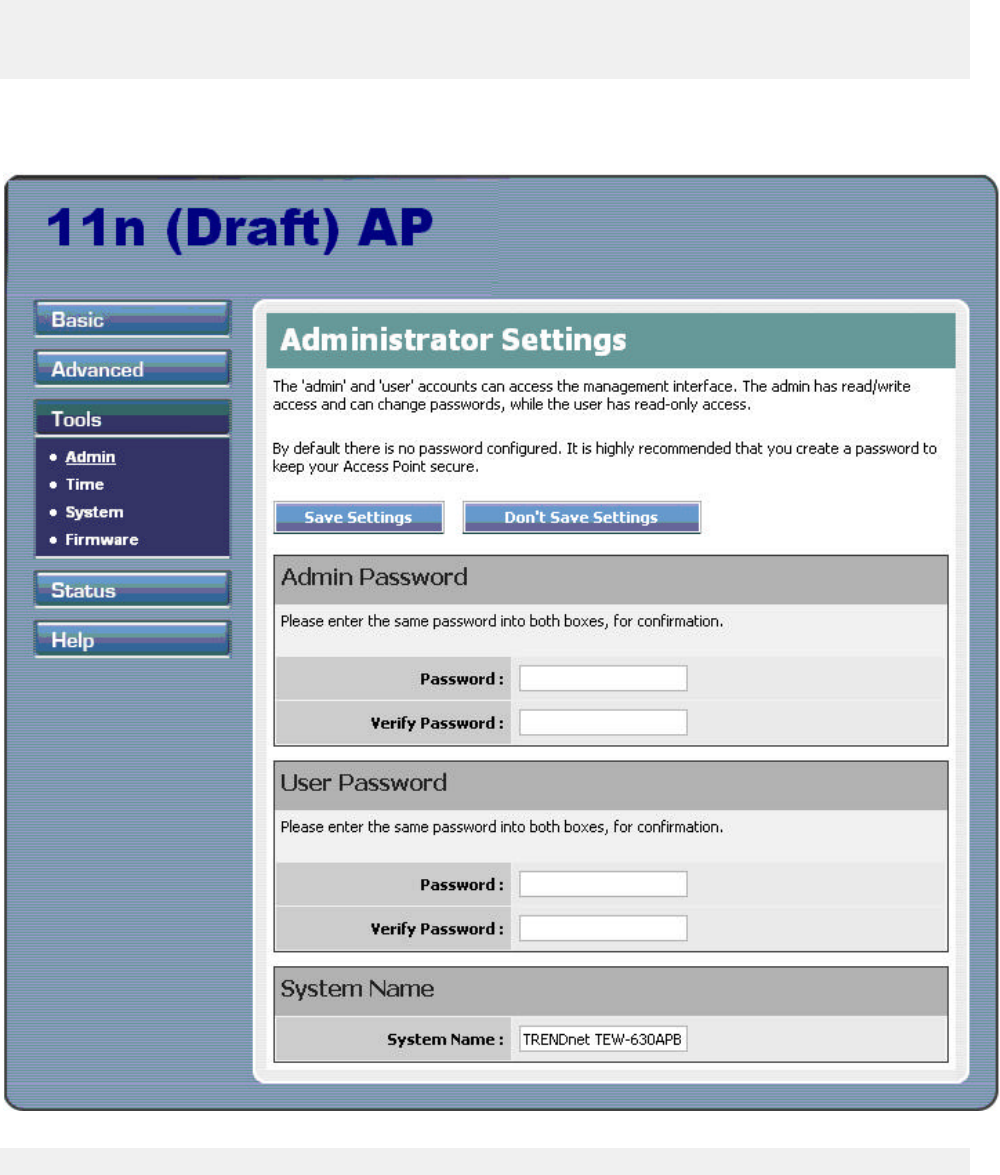
Page 29
Tools
The Tools tab provides the following configuration options: Admin, Time, System and Firmware.
Tool_Admin
The Admin option is used to set a password for access to the Web-based management. By default
there is no password configured. It is highly recommended that you create a password to keep
your new Access Point secure.
Admin Password

Page 30
Enter a password for the user "admin", who will have full access to the Web-based
management interface.
User Password
Enter a password for the user "user", who will have read-only access to the Web-based
management interface.
System Name
The name of the Access Point can be changed here.
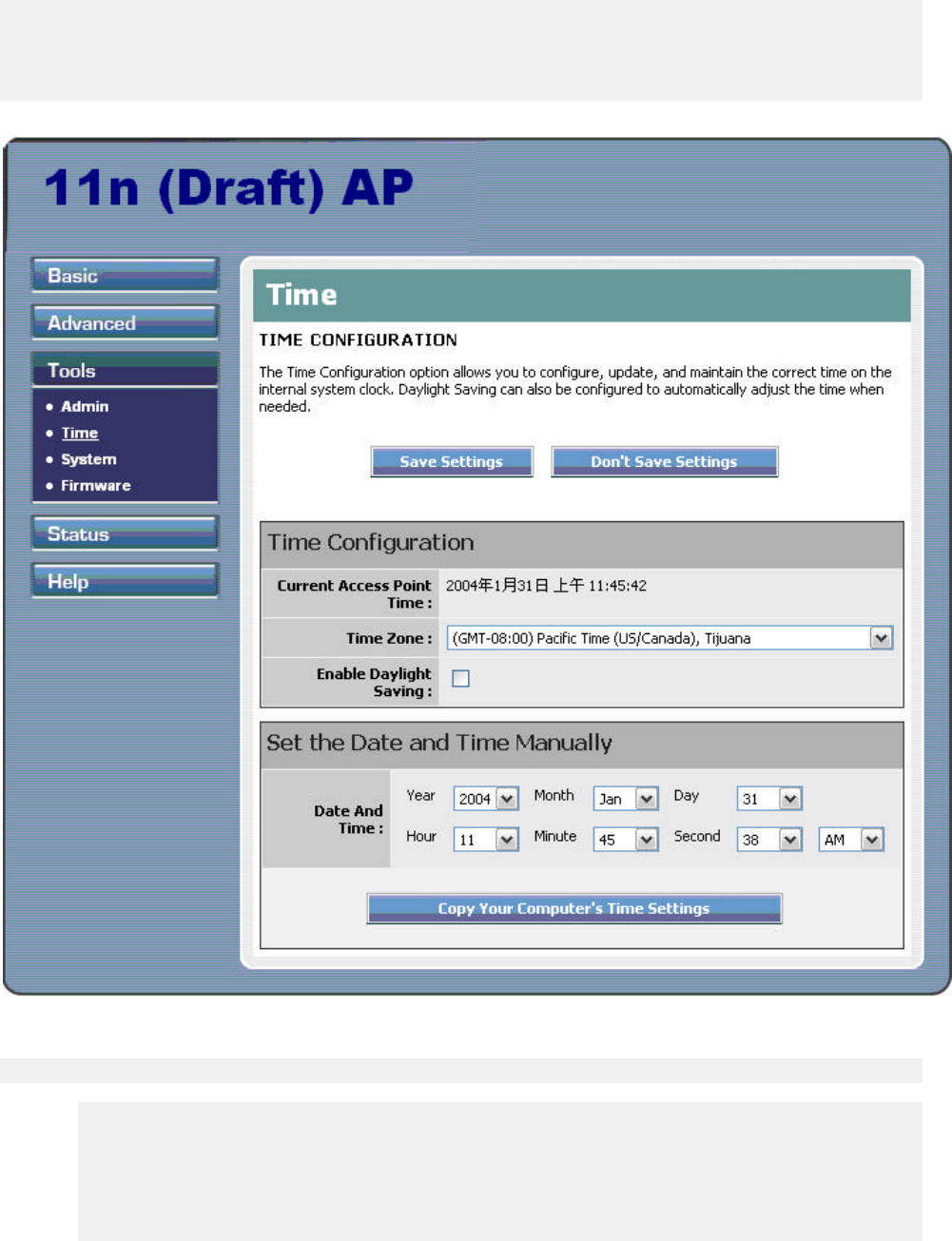
Page 31
Tool_Time
The Time Configuration option allows you to configure, update, and maintain the correct time on
the Access Point's internal system clock. From this section you can set the time zone that you are
in and set the Time Server. Daylight saving can also be configured to automatically adjust the time
when needed.
Time Configuration
Current Access Point Time
Displays the time currently maintained by the Access Point. If this is not correct, use the
following options to configure the time correctly.
Time Zone

Page 32
Select your local time zone from pull down menu.
Enable Daylight Saving
Check this option if your location observes daylight saving time.
Daylight Saving Offset
Select the time offset, if your location observes daylight saving time.
DST Start and DST End
Select the starting and ending times for the change to and from daylight saving time. For
example, suppose for DST Start you select Month="Oct", Week="3rd", Day="Sun" and
Time="2am". This is the same as saying: "Daylight saving starts on the third Sunday of
October at 2:00 AM."
Set the Date and Time Manually
If you do not have the NTP Server option in effect, you can either manually set the time
for your Access Point here, or you can click the Copy Your Computer's Time Settings
button to copy the time from the computer you are using. (Make sure that computer's
time is set correctly.)
Note: If the Access Point loses power for any reason, it cannot keep its clock running, and will not
have the correct time when it is started again. To maintain correct time for schedules and logs,
either you must enter the correct time after you restart the Access Point, or you must enable the
NTP Server option.
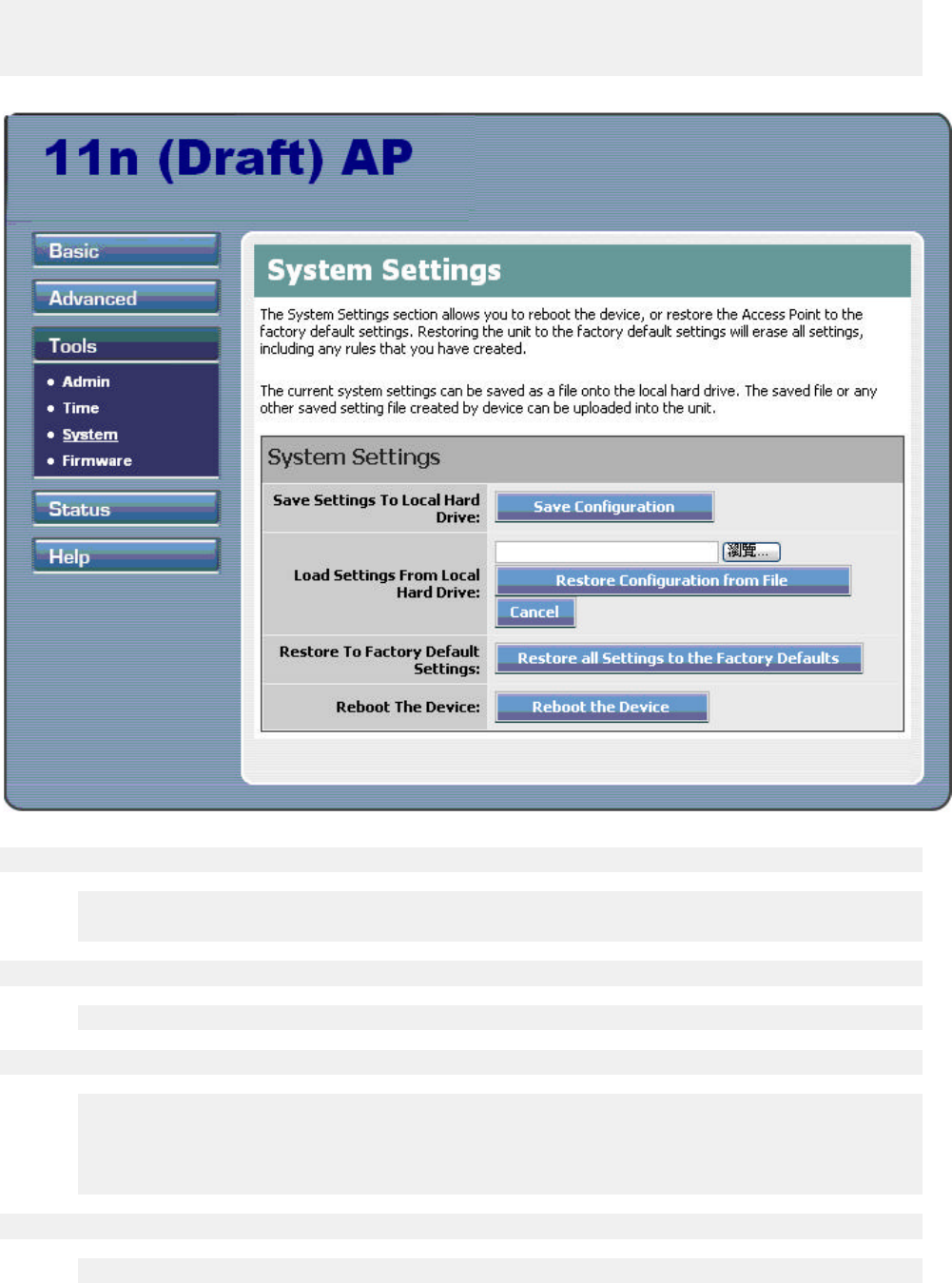
Page 33
Tool_System
This section allows you to manage the Access Point's configuration settings, reboot the Access
Point, and restore the Access Point to the factory default settings. Restoring the unit to the factory
default settings will erase all settings, including any rules that you've created.
Save Settings To Local Hard Drive
This option allows you to save the Access Point's configuration to a file on your computer.
Be sure to save the configuration before performing a firmware upgrade.
Load Settings From Local Hard Drive
Use this option to restore previously saved Access Point configuration settings.
Restore To Factory Default Settings
This option restores all configuration settings back to the settings that were in effect at
the time the Access Point was shipped from the factory. Any settings that have not been
saved will be lost. If you want to save your Access Point configuration settings, use the
Save Settings option above.
Reboot The Device
This restarts the Access Point. Useful for restarting when you are not near the de
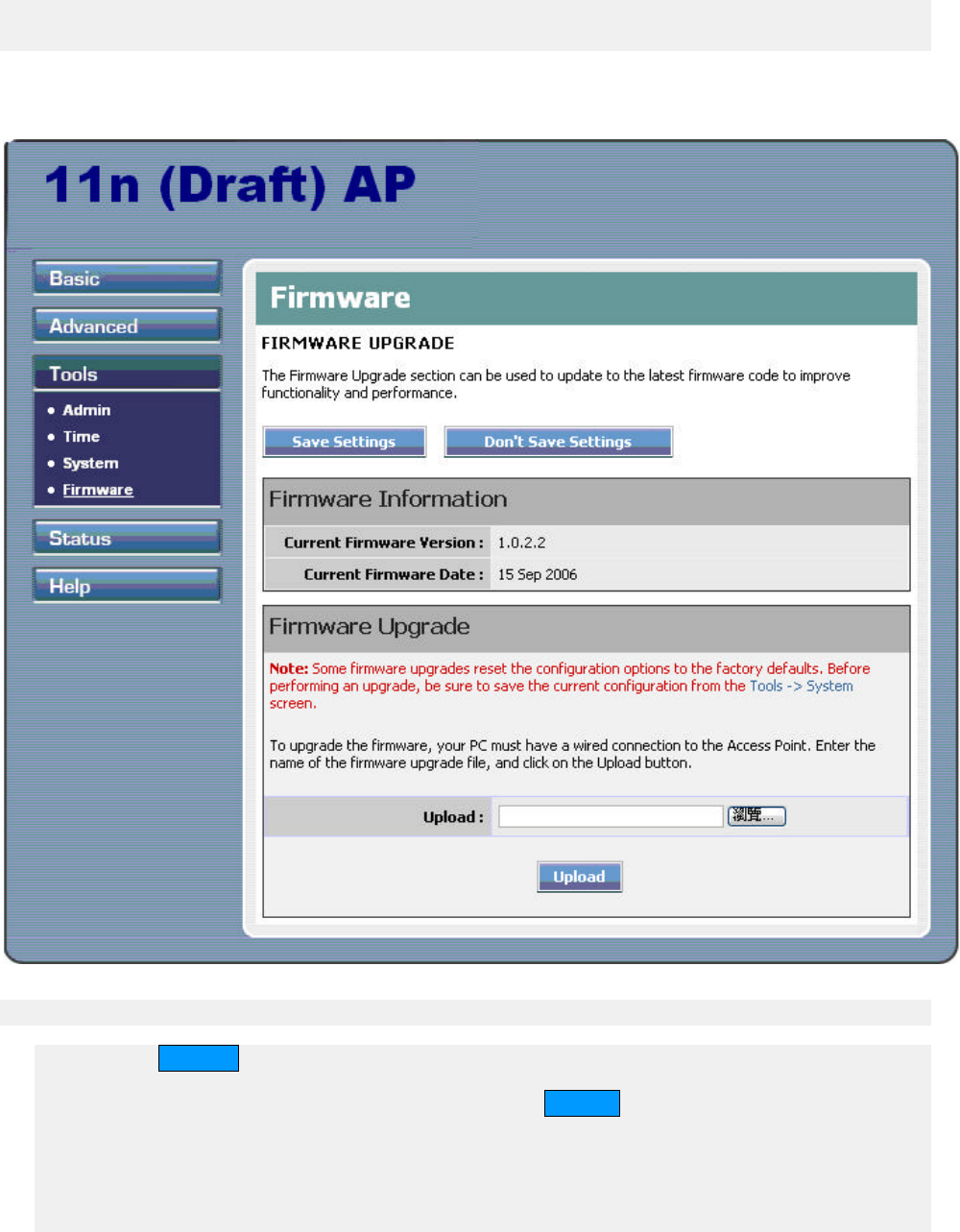
Page 34
Tool_Firmware
The Firmware Upgrade section can be used to update to the latest firmware code to improve
functionality and performance.
To upgrade the firmware, follow these steps:
1. Click the Browse button to locate the upgrade file on your computer.
2. Once you have found the file to be used, click the Upload button below to start the
firmware upgrade process. This can take a minute or more.
3. Wait for the Access Point to reboot. This can take another minute or more.
4. Confirm updated firmware revision on status page.

Page 35
Firmware Information
Here are displayed the version numbers of the firmware currently installed in your Access
Point and the most recent upgrade that is available.
Firmware Upgrade
Note: Firmware upgrade cannot be performed from a wireless device. To perform an
upgrade, ensure that you are using a PC that is connected to the Access Point by wire.
Note: Some firmware upgrades reset the configuration options to the factory defaults.
Before performing an upgrade, be sure to save the current configuration from the
Tools -> Admin screen.
Upload
Once you have a firmware update on your computer, use this option to browse for the file
and then upload the information into the Access Point.
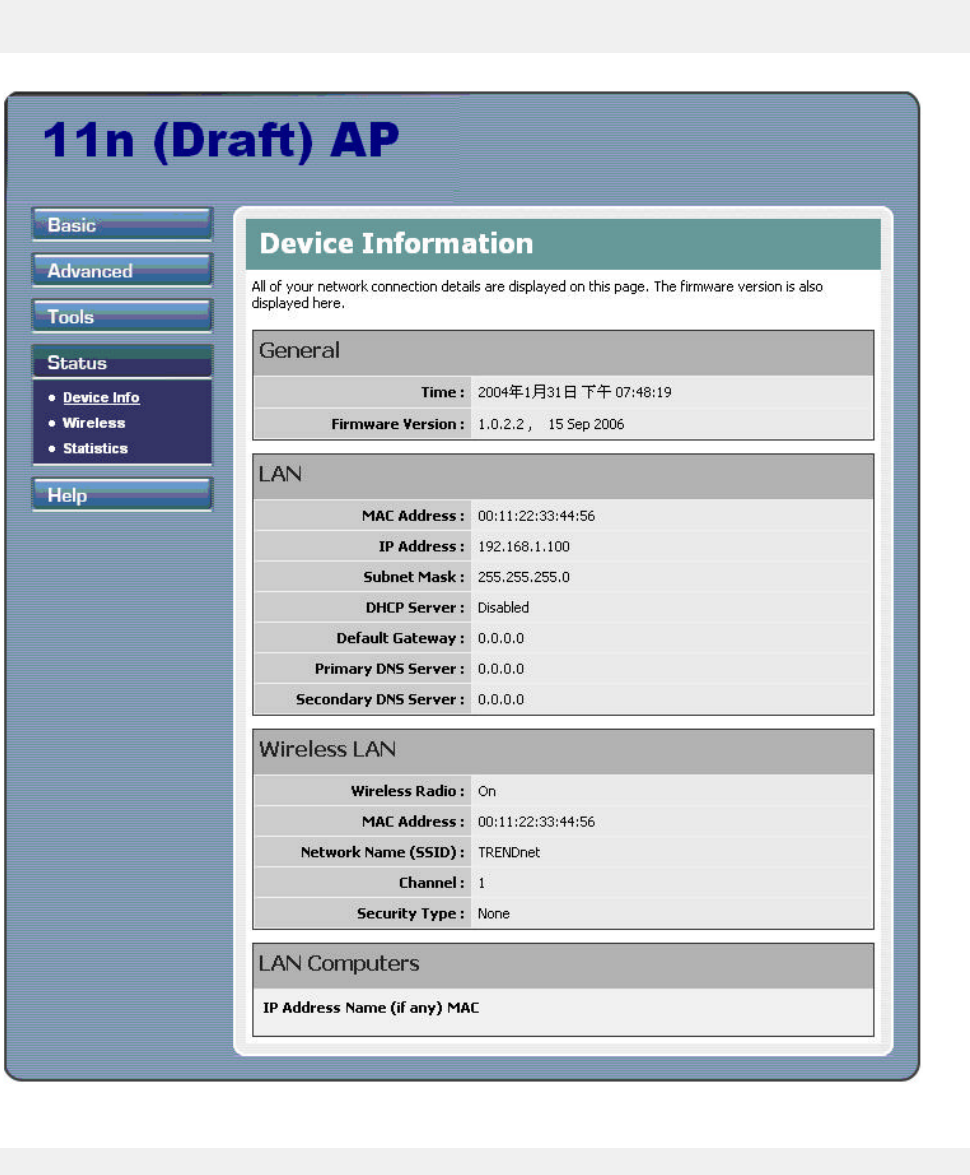
Page 36
Status
The Status tab provides the following configuration options: Device Info, Wireless and Statistics.
Status_Device Info
All of your network connection details are displayed on the Device Info page. The firmware version
is also displayed here.
LAN Computers
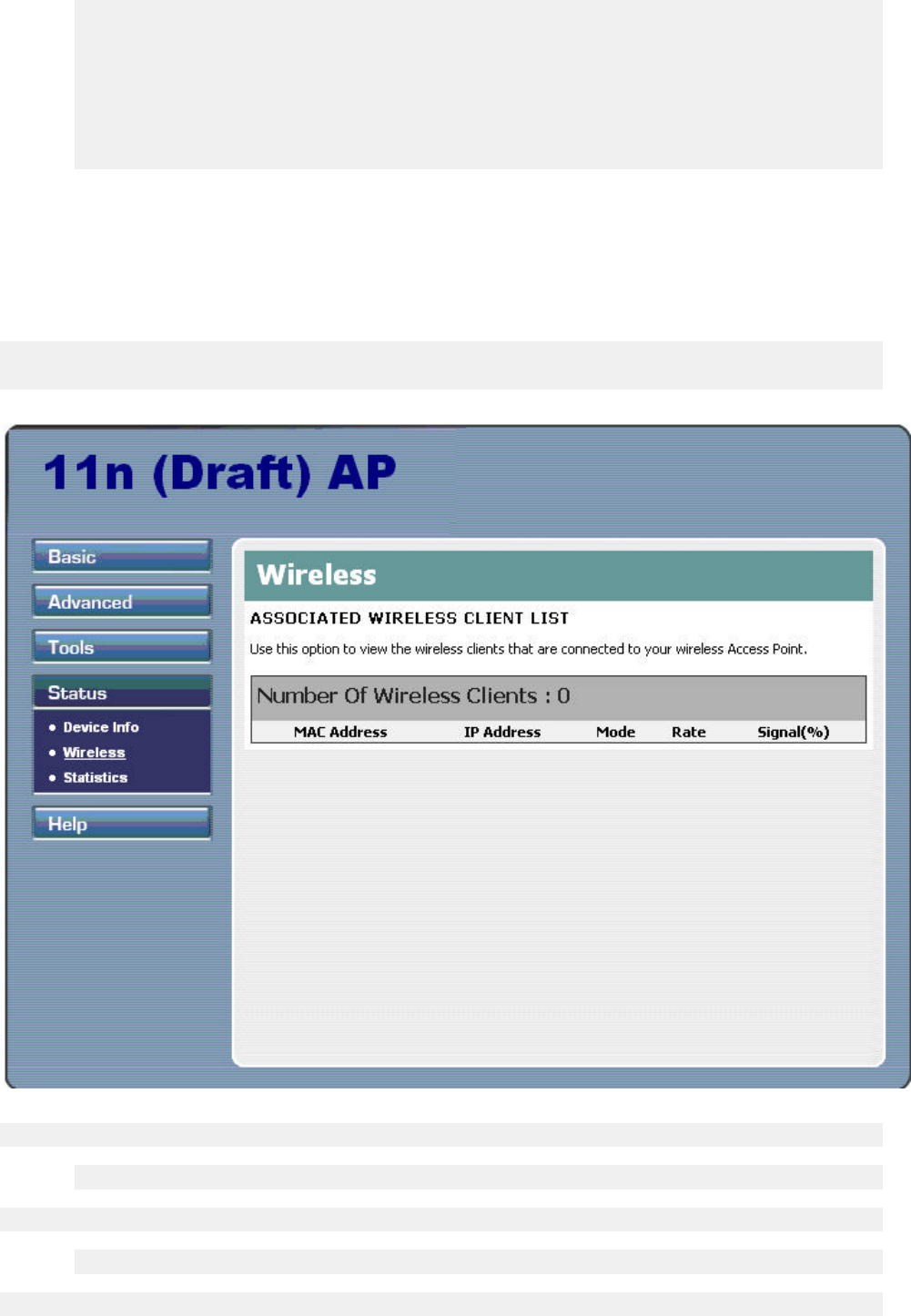
Page 37
This area of the screen continually updates to show all DHCP enabled computers and
devices connected to the LAN side of your Access Point. The detection "range" is limited
to the address range as configured in DHCP Server. Computers that have an address
outside of this range will not show. If the DHCP Client (i.e. a computer configured to
"Automatically obtain an address") supplies a Host Name then that will also be shown.
Any computer or device that has a static IP address that lies within the detection "range"
may show, however its host name will not.
Status_Wireless
The wireless section allows you to view the wireless clients that are connected to your wireless
Access Point.
MAC Address
The Ethernet ID (MAC address) of the wireless client.
IP Address
The LAN-side IP address of the client.
Mode

Page 38
The transmission standard being used by the client. Values are 802.11b, 802.11g, or
802.11ng respectively.
Rate
The actual transmission rate of the client in megabits per second.
Signal
This is a relative measure of signal quality. The value is expressed as a percentage of
theoretical best quality. Signal quality can be reduced by distance, by interference from
other radio-frequency sources (such as cordless telephones or neighboring wireless
networks), and by obstacles between the Access Point and the wireless device.
Status_Statistics
The Statistics page displays all of the LAN and Wireless packet transmit and receive statistics.
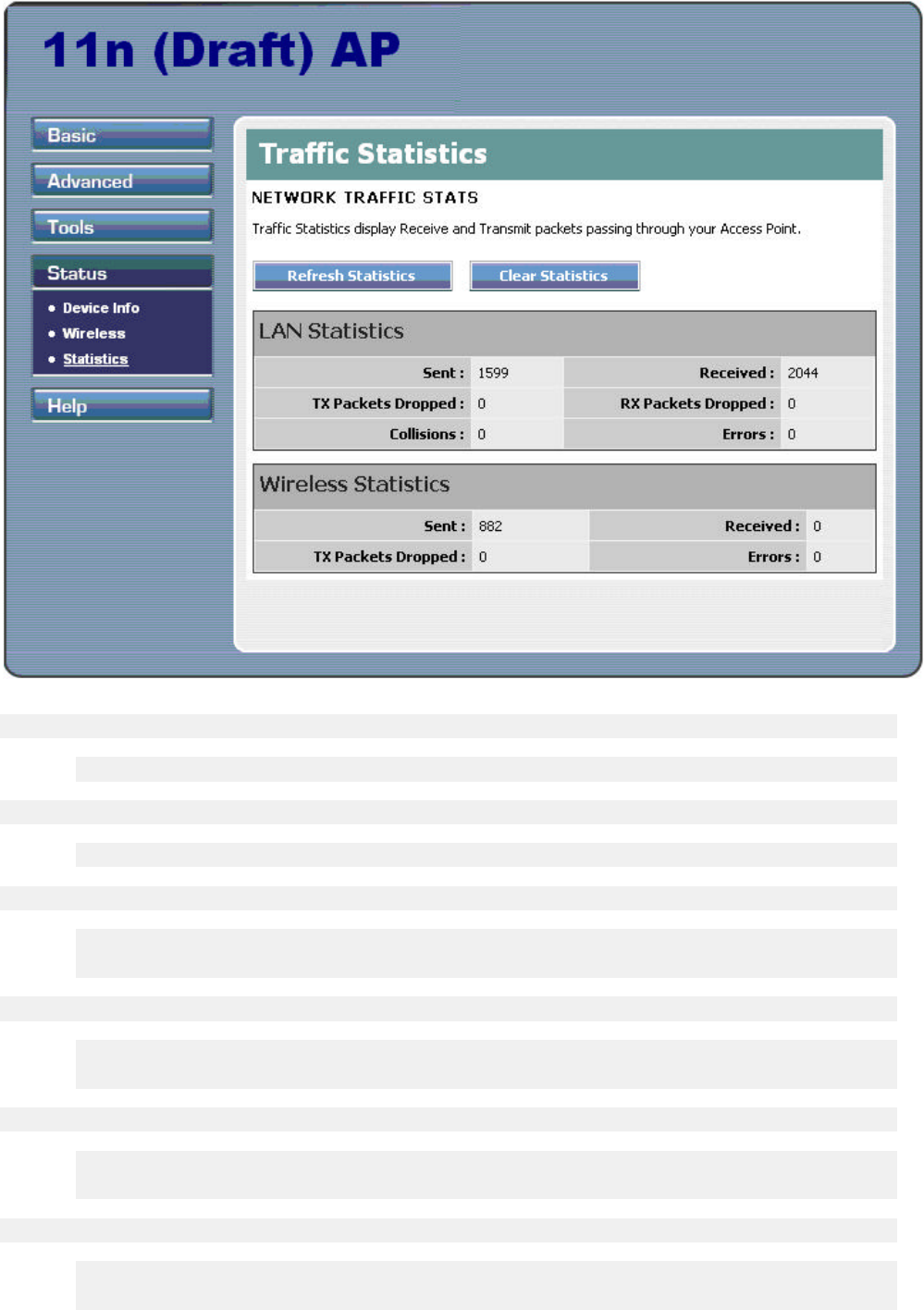
Page 39
Sent
The number of packets sent from the Access Point.
Received
The number of packets received by the Access Point.
TX Packets Dropped
The number of packets that were dropped while being sent, due to errors, collisions, or
Access Point resource limitations.
RX Packets Dropped
The number of packets that were dropped while being received, due to errors, collisions,
or Access Point resource limitations.
Collisions
The number of packets that were dropped due to Ethernet collisions (two or more devices
attempting to use an Ethernet circuit at the same time).
Errors
The number of transmission failures that cause loss of a packet. A noisy radio-frequency
environment can cause a high error rate on the wireless LAN.
Page 40

Page 41
Glossary
A
Access Control List
ACL. This is a database of network devices that are allowed to access resources on the
network.
Access Point
AP. Device that allows wireless clients to connect to it and access the network
Ad-hoc network
Peer-to-Peer network between wireless clients
Address Resolution Protocol
ARP. Used to map MAC addresses to IP addresses so that conversions can be made in
both directions.
Advanced Encryption Standard
AES. Government encryption standard
Alphanumeric
Characters A-Z and 0-9
Antenna
Used to transmit and receive RF signals.
ASCII
American Standard Code for Information Interchange. This system of characters is most
commonly used for text files
Attenuation
The loss in strength of digital and analog signals. The loss is greater when the signal is
being transmitted over long distances.
Authentication
To provide credentials, like a Password, in order to verify that the person or device is really
who they are claiming to be
Automatic Private IP Addressing
APIPA. An IP address that that a Windows computer will assign itself when it is configured
to obtain an IP address automatically but no DHCP server is available on the network
B
Backward Compatible
The ability for new devices to communicate and interact with older legacy devices to
guarantee interoperability
Bandwidth

Page 42
The maximum amount of bytes or bits per second that can be transmitted to and from a
network device
Beacon
A data frame by which one of the stations in a Wi-Fi network periodically broadcasts
network control data to other wireless stations.
Bit rate
The amount of bits that pass in given amount of time
Bit/sec
Bits per second
BOOTP
Bootstrap Protocol. Allows for computers to be booted up and given an IP address with no
user intervention
Broadcast
Transmitting data in all directions at once
Browser
A program that allows you to access resources on the web and provides them to you
graphically
C
CAT 5
Category 5. Used for 10/100 Mbps or 1Gbps Ethernet connections
Client
A program or user that requests data from a server
Collision
When do two devices on the same Ethernet network try and transmit data at the exact
same time.
Cookie
Information that is stored on the hard drive of your computer that holds your preferences to
the site that gave your computer the cookie
D
Data
Information that has been translated into binary so that it can be processed or moved to
another device
Data-Link layer
The second layer of the OSI model. Controls the movement of data on the physical link of a
network
dBd

Page 43
Decibels related to dipole antenna
dBi
Decibels relative to isotropic radiator
dBm
Decibels relative to one milliwatt
Decrypt
To unscramble an encrypted message back into plain text
Default
A predetermined value or setting that is used by a program when no user input has been
entered for this value or setting
DHCP
Dynamic Host Configuration Protocol: Used to automatically assign IP addresses from a
predefined pool of addresses to computers or devices that request them
Digital certificate:
An electronic method of providing credentials to a server in order to have access to it or a
network
Direct Sequence Spread Spectrum
DSSS: Modulation technique used by 802.11b wireless devices
DNS
Domain Name System: Translates Domain Names to IP addresses
Domain name
A name that is associated with an IP address
Download
To send a request from one computer to another and have the file transmitted back to the
requesting computer
Duplex
Sending and Receiving data transmissions at the sane time
Dynamic IP address
IP address that is assigned by a DHCP server and that may change. Cable Internet
providers usually use this method to assign IP addresses to their customers.
E
EAP
Extensible Authentication Protocol
Encryption
Converting data into cyphertext so that it cannot be easily read

Page 44
Ethernet
The most widely used technology for Local Area Networks.
F
File server
A computer on a network that stores data so that the other computers on the network can
all access it
File sharing
Allowing data from computers on a network to be accessed by other computers on the
network with different levels of access rights
Firewall
A device that protects resources of the Local Area Network from unauthorized users
outside of the local network
Firmware
Programming that is inserted into a hardware device that tells it how to function
Fragmentation
Breaking up data into smaller pieces to make it easier to store
FTP
File Transfer Protocol. Easiest way to transfer files between computers on the Internet
Full-duplex
Sending and Receiving data at the same time
G
Gain
The amount an amplifier boosts the wireless signal
Gateway
A device that connects your network to another, like the internet
Gbps
Gigabits per second
Gigabit Ethernet
Transmission technology that provides a data rate of 1 billion bits per second
GUI
Graphical user interface
H
Half-duplex
Data cannot be transmitted and received at the same time

Page 45
Hashing
Transforming a string of characters into a shorter string with a predefined length
Hexadecimal
Characters 0-9 and A-F
Hop
The action of data packets being transmitted from one AP to another
Host
Computer on a network
HTTP
Hypertext Transfer Protocol is used to transfer files from HTTP servers (web servers) to
HTTP clients (web browsers)
HTTPS
HTTP over SSL is used to encrypt and decrypt HTTP transmissions
Hub
A networking device that connects multiple devices together
I
ICMP
Internet Control Message Protocol
IEEE
Institute of Electrical and Electronics Engineers
IGMP
Internet Group Management Protocol is used to make sure that computers can report their
multicast group membership to adjacent APs
IIS
Internet Information Server is a WEB server and FTP server provided by Microsoft
Infrastructure
In terms of a wireless network, this is when wireless clients use an Access Point to gain
access to the network
Internet
A system of worldwide networks which use TCP/IP to allow for resources to be accessed
from computers around the world
Internet Explorer
A World Wide Web browser created and provided by Microsoft
Internet Protocol

Page 46
The method of transferring data from one computer to another on the Internet
Internet Protocol Security
IPsec provides security at the packet processing layer of network communication
Internet Service Provider
An ISP provides access to the Internet to individuals or companies
Intranet
A private network
Intrusion Detection
A type of security that scans a network to detect attacks coming from inside and outside of
the network
IP
Internet Protocol
IP address
A 32-bit number, when talking about Internet Protocol Version 4, that identifies each
computer that transmits data on the Internet or on an Intranet
IPsec
Internet Protocol Security
IPX
Internetwork Packet Exchange is a networking protocol developed by Novel to enable their
Netware clients and servers to communicate
ISP
Internet Service Provider
J
Java
A programming language used to create programs and applets for web pages
K
Kbps
Kilobits per second
Kbyte
Kilobyte
L
LAN
Local Area Network
Latency

Page 47
The amount of time that it takes a packet to get from the one point to another on a network.
Also referred to as delay
LED
Light Emitting Diode
Legacy
Older devices or technology
Local Area Network
A group of computers in a building that usually access files from a server
LPR/LPD
"Line Printer Requestor"/"Line Printer Daemon". A TCP/IP protocol for transmitting streams
of printer data.
L2TP
Layer 2 Tunneling Protocol
M
MAC address
A unique hardware ID assigned to every Ethernet adapter by the manufacturer.
Mbps
Megabits per second
MDI
Medium Dependent Interface is an Ethernet port for a connection to a straight-through
cable
MDIX
Medium Dependent Interface Crossover, is an Ethernet port for a connection to a crossover
cable
MIB
Management Information Base is a set of objects that can be managed by using SNMP
Modem
A device that Modulates digital signals from a computer to an analog signal in order to
transmit the signal over phone lines. It also Demodulates the analog signals coming from
the phone lines to digital signals for your computer
MPPE
Microsoft Point-to-Point Encryption is used to secure data transmissions over PPTP
connections
MTU
Maximum Transmission Unit is the largest packet that can be transmitted on a
packet-based network like the Internet

Page 48
Multicast
Sending data from one device to many devices on a network
N
NAT
Network Address Translation allows many private IP addresses to connect to the Internet,
or another network, through one IP address
NetBEUI
NetBIOS Extended User Interface is a Local Area Network communication protocol. This is
an updated version of NetBIOS
NetBIOS
Network Basic Input/Output System
Netmask
Determines what portion of an IP address designates the Network and which part
designates the Host
Network Interface Card
A card installed in a computer or built onto the motherboard that allows the computer to
connect to a network
Network Layer
The third layer of the OSI model which handles the routing of traffic on a network
Network Time Protocol
Used to synchronize the time of all the computers in a network
NIC
Network Interface Card
NTP
Network Time Protocol
O
OFDM
Orthogonal Frequency-Division Multiplexing is the modulation technique for both 802.11a
and 802.11g
OSI
Open Systems Interconnection is the reference model for how data should travel between
two devices on a network
OSPF
Open Shortest Path First is a routing protocol that is used more than RIP in larger scale
networks because only changes to the routing table are sent to all the other APs in the
network as opposed to sending the entire routing table at a regular interval, which is how
RIP functions

Page 49
P
Password
A sequence of characters that is used to authenticate requests to resources on a network
Personal Area Network
The interconnection of networking devices within a range of 10 meters
Physical layer
The first layer of the OSI model. Provides the hardware means of transmitting electrical
signals on a data carrier
Ping
A utility program that verifies that a given Internet address exists and can receive
messages. The utility sends a control packet to the given address and waits for a response.
PoE
Power over Ethernet is the means of transmitting electricity over the unused pairs in a
category 5 Ethernet cable
Port
A logical channel endpoint in a network. A computer might have only one physical channel
(its Ethernet channel) but can have multiple ports (logical channels) each identified by a
number.
PPP
Point-to-Point Protocol is used for two computers to communicate with each over a serial
interface, like a phone line
PPPoE
Point-to-Point Protocol over Ethernet is used to connect multiple computers to a remote
server over Ethernet
PPTP
Point-to-Point Tunneling Protocol is used for creating VPN tunnels over the Internet
between two networks
Preamble
Used to synchronize communication timing between devices on a network
Q
QoS
Quality of Service
R
RADIUS
Remote Authentication Dial-In User Service allows for remote users to dial into a central
server and be authenticated in order to access resources on a network
Reboot

Page 50
To restart a computer and reload it's operating software or firmware from nonvolatile
storage.
Rendezvous
Apple's version of UPnP, which allows for devices on a network to discover each other and
be connected without the need to configure any settings
Repeater
Retransmits the signal of an Access Point in order to extend it's coverage
RIP
Routing Information Protocol is used to synchronize the routing table of all the APs on a
network
RJ-11
The most commonly used connection method for telephones
RJ-45
The most commonly used connection method for Ethernet
RS-232C
The interface for serial communication between computers and other related devices
RSA
Algorithm used for encryption and authentication
S
Server
A computer on a network that provides services and resources to other computers on the
network
Session key
An encryption and decryption key that is generated for every communication session
between two computers
Session layer
The fifth layer of the OSI model which coordinates the connection and communication
between applications on both ends
Simple Mail Transfer Protocol
Used for sending and receiving email
Simple Network Management Protocol
Governs the management and monitoring of network devices
SIP
Session Initiation Protocol. A standard protocol for initiating a user session that involves
multimedia content, such as voice or chat.

Page 51
SMTP
Simple Mail Transfer Protocol
SNMP
Simple Network Management Protocol
SOHO
Small Office/Home Office
SPI
Stateful Packet Inspection
SSH
Secure Shell is a command line interface that allows for secure connections to remote
computers
SSID
Service Set Identifier is a name for a wireless network
Stateful inspection
A feature of a firewall that monitors outgoing and incoming traffic to make sure that only
valid responses to outgoing requests are allowed to pass though the firewall
Subnet mask
Determines what portion of an IP address designates the Network and which part
designates the Host
Syslog
System Logger -- a distributed logging interface for collecting in one place the logs from
different sources. Originally written for UNIX, it is now available for other operating systems,
including Windows.
T
TCP
Transmission Control Protocol
TCP/IP
Transmission Control Protocol/Internet Protocol
TCP Raw
A TCP/IP protocol for transmitting streams of printer data.
TFTP
Trivial File Transfer Protocol is a utility used for transferring files that is simpler to use than
FTP but with less features
Throughput
The amount of data that can be transferred in a given time period

Page 52
Traceroute
A utility displays the routes between you computer and specific destination
U
UDP
User Datagram Protocol
Unicast
Communication between a single sender and receiver
Universal Plug and Play
A standard that allows network devices to discover each other and configure themselves to
be a part of the network
Upgrade
To install a more recent version of a software or firmware product
Upload
To send a request from one computer to another and have a file transmitted from the
requesting computer to the other
UPnP
Universal Plug and Play
URL
Uniform Resource Locator is a unique address for files accessible on the Internet
USB
Universal Serial Bus
UTP
Unshielded Twisted Pair
V
Virtual Private Network
VPN: A secure tunnel over the Internet to connect remote offices or users to their
company's network
VLAN
Virtual LAN
Voice over IP
Sending voice information over the Internet as opposed to the PSTN
VoIP
Voice over IP
W

Page 53
Wake on LAN
Allows you to power up a computer though it's Network Interface Card
WAN
Wide Area Network
WCN
Windows Connect Now. A Microsoft method for configuring and bootstrapping wireless
networking hardware (access points) and wireless clients, including PCs and other devices.
WDS
Wireless Distribution System. A system that enables the interconnection of access points
wirelessly.
Web browser
A utility that allows you to view content and interact with all of the information on the World
Wide Web
WEP
Wired Equivalent Privacy is security for wireless networks that is supposed to be
comparable to that of a wired network
Wi-Fi
Wireless Fidelity
Wi-Fi Protected Access
An updated version of security for wireless networks that provides authentication as well as
encryption
Wide Area Network
The larger network that your LAN is connected to, which may be the Internet itself, or a
regional or corporate network
Wireless ISP
A company that provides a broadband Internet connection over a wireless connection
Wireless LAN
Connecting to a Local Area Network over one of the 802.11 wireless standards
WISP
Wireless Internet Service Provider
WLAN
Wireless Local Area Network
WPA
Wi-Fi Protected Access. A Wi-Fi security enhancement that provides improved data
encryption, relative to WEP.

Page 54
X
xDSL
A generic term for the family of digital subscriber line (DSL) technologies, such as ADSL,
HDSL, RADSL, and SDSL.
Y
Yagi antenna
A directional antenna used to concentrate wireless signals on a specific location
Z
#
1
802.11
A family of specifications for wireless local area networks (WLANs) developed by a working
group of the Institute of Electrical and Electronics Engineers (IEEE).